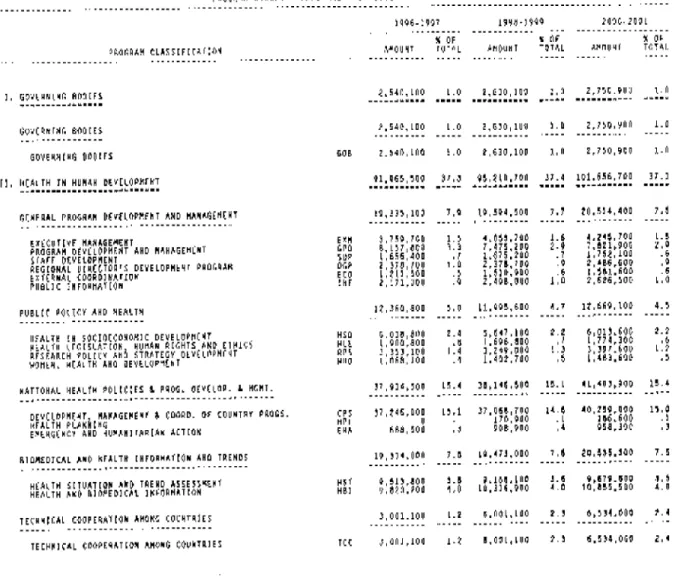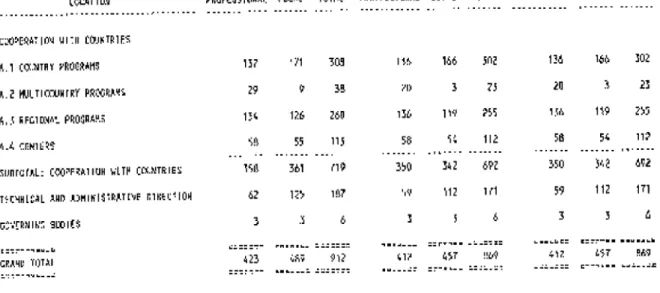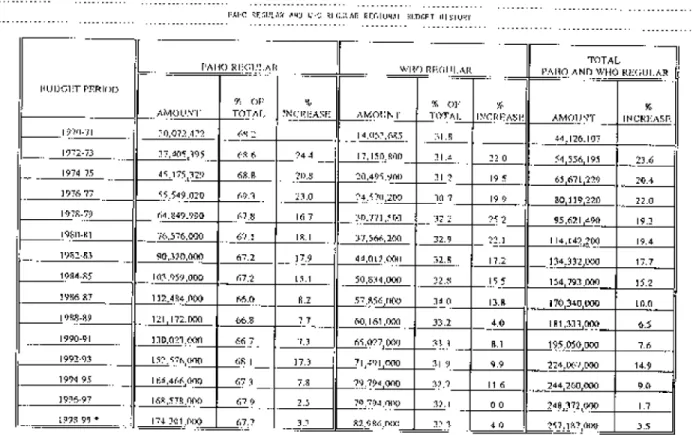SUBCOMMITTEE ON PLANNING AND PROGRAMMING
OF THE EXECUTIVE COMMITTEE OF THE DIRECTING COUNCIL28th Meeting, Washington, D.C., 3-4 April 1997
________________________________________________________________________________
Provisional Agenda Item 3 SPP28/3 (Eng.) 14 March 1997
ORIGINAL: ENGLISH
PROPOSED PROGRAM BUDGET OF THE
PAN AMERICAN HEALTH ORGANIZATION
FOR THE BIENNIUM 1998-1999
BACKGROUND 2
TABLE A.: PAHOWHO REGULAR BUDGET ANALYSIS OF
PROGRAM AND COST INCREASES (AND DECREASES) BY LOCATION 4
TABLE B. TOTAL PROGRAM BUDGET - PAHO AND WHO
REGULAR FUNDS 5
TABLE B.1. COUNTRY PROGRAMS. PROGRAM BUDGET
-PAHO AND WHO REGULAR FUNDS 6
TABLE B.2. ALL OTHER PROGRAMS. PROGRAM BUDGET
-PAHO AND WHO REGULAR FUNDS 7
TABLE C. PAHO CLASSIFIED LIST OF PROGRAMS 1998-1999 8
TABLE D. POST ANALYSIS - PAHO AND WHO REGULAR BUDGET 9
TABLE E. PAHO REGULAR AND WHO REGULAR REGIONAL
BACKGROUND
The original 1998-1999 program budget projection was presented in Official Document 267 of May 1995. At that time, the PAHO Regular funds were projected to increase by 8.0% over 1996-1997, and the WHO Regular funds were projected to increase by 8.2%. The combined regular funds, which constitute the core budget of the Organization, were projected to increase by 8.1%.
The projections, with revised and updated cost increase averages, were used in developing the WHO Regular Budget proposal for the Region of the Americas for 1998-1999 which was presented to the Subcommittee, the Executive Committee, and the Directing Council last year. In accordance with the instructions of the Director-General of WHO, the 1998-1999 proposal was to be presented, without cost increases, at the level of the 1996-1997 program budget of $79,794,000, which was also the same for the 1994-1995 biennium. Cost increases were discussed with the WHO Executive Board at its meeting in January 1997, and the Director-General will present the proposal to the May 1997 World Health Assembly. The cost increase for the Americas Region included in the documentation presented to the Executive Board was 4.0% or $3,192,000, which would provide $82,986,000 for 1998-1999. It is this amount which is used for WHO Regular funds in this document, pending approval by the WHA in May 1997.
In late 1996, country, center, and regional program offices were requested to make 1998-1999 proposals and 2000-2001 projections related to the combined PAHOWHO Regular funded programs. These proposals were reviewed by the Director’s Cabinet from late February to early March of this year.
The overall PAHOWHO Regular budget proposal is $257,187,000, which requires a total increase of 3.5%. As mentioned previously, the WHO Regular portion is $82,986,000, subject to the approval of the World Health Assembly in May. The PAHO Regular portion is $174,201,000, which reflects an increase of 3.3% or $5,623,000.
The 1996-1997 PAHO Regular budget of $168,578,000 was funded by $156,878,000 in quotas from Member Governments and $11,700,000 in miscellaneous income. In 1998-1999, it is proposed that the PAHO Regular budget of $174,201,000 be funded by $162,501,000 from quotas and $11,700,000 in projected miscellaneous income. Thus, the portion of the budget funded by quotas from Member Governments will increase by 3.6%.
The cost increase factors related to inflation used for the non-post elements of the budget are calculated at 3.0% annually for Washington (based primarily upon the current consumer price index for the United States), and 6.25% for 1998 and 5.51% for 1999 for the field offices (based upon a conservative interpretation of two econometric forecasts). These factors were used despite the fact that the 1996 regional weighted average for inflation in Latin America and the Caribbean was 20.0%, according to the December 1996 preliminary report of the United Nations Economic Commission for Latin America and the Caribbean (ECLAC). However, based upon decisions made during the Director’s Cabinet consideration of this proposal, the actual biennial increases amount to 2.01% annually for Washington and 2.26% annually for the field locations. Thus, PAHO is absorbing approximately $3.5 million in real terms in the 1998-1999 biennium.
For the Subcommittee’s information, attached are several preliminary tables which provide more details.
Table A is an analysis of the budget proposal by location of the funds, by program increasesdecreases, and by cost increases for 1998-1999 compared with 1996-1997. The total increase of 3.5% is composed of cost increases of 5.9% and program decreases of 2.4%. Country Programs increase from 40.0% of the total in 1996-1997 to 40.9% in 1998-1999, and Country Programs receive 66.7% of the overall increase.
Table B presents the 1998-1999 proposal by the PAHO Classified List of Programs (CLP)
Table B-1 presents the proposal solely for the Country Programs according to the CLP, while Table B-2 shows the proposal for All Other Programs in the CLP format.
Table C provides short descriptions of the various programs under the CLP.
Table D show the analysis of the posts by location.
TABLE B.1. COUNTRY PROGRAMS.
TABLE B.2. ALL OTHER PROGRAMS.
TABLE C. PAHO CLASSIFIED LIST OF PROGRAMS 1998-1999




